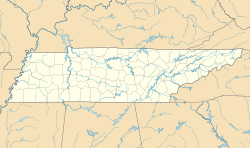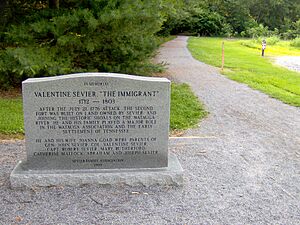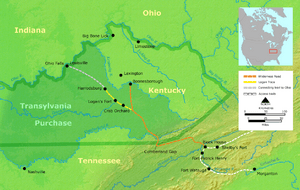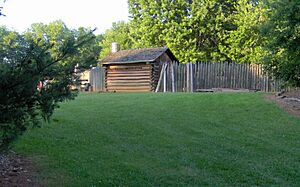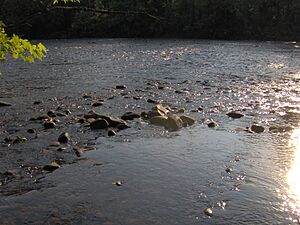Sycamore Shoals facts for kids
|
Sycamore Shoals
|
|
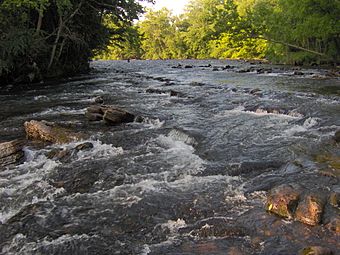
Sycamore Shoals
|
|
| Nearest city | Elizabethton, Tennessee |
|---|---|
| NRHP reference No. | 66000721 |
Quick facts for kids Significant dates |
|
| Added to NRHP | October 15, 1966 |
| Designated NHL | July 19, 1964 |
The Sycamore Shoals is a special place along the Watauga River in Elizabethton, Tennessee. It's a rocky area where the river flows quickly, like small waterfalls. For thousands of years, Native Americans, especially the Cherokee people, lived and gathered here.
Later, when European settlers moved west, Sycamore Shoals became very important. It was a key spot for military plans and helped shape the early history of Tennessee and Kentucky. Today, Sycamore Shoals is a protected National Historic Landmark. You can visit it at Sycamore Shoals State Historic Park.
In 1770, explorer James Robertson found the flat, open lands at Sycamore Shoals. He called them the Watauga Old Fields. Soon after, he led a group of settlers to this area. In 1772, these settlers created the Watauga Association. This was one of the first governments west of the Appalachian Mountains. It was like the first seed for what would become the state of Tennessee.
A few years later, in 1775, Richard Henderson and Daniel Boone made a big land deal here. They signed the Treaty of Sycamore Shoals with the Cherokee. They bought a huge part of what is now Kentucky and Tennessee. The next year, settlers at Fort Watauga fought off a Cherokee attack. This battle led to many stories about heroes like Nancy Ward and John Sevier.
During the American Revolutionary War in 1780, a group of frontier fighters called the Overmountain Men met at Sycamore Shoals. From here, they marched across the mountains. They went on to win a major battle against British supporters at the Battle of Kings Mountain.
Contents
Where is Sycamore Shoals?
Sycamore Shoals is located in Elizabethton, Tennessee. It's about 23 miles (37 km) upstream from where the Watauga River joins another river. It's also about 3 miles (5 km) downstream from where the Watauga River meets the Doe River.
The Tennessee Department of Environment and Conservation manages the shoals. After the shoals, the Watauga River flows for another 8 miles (13 km). Then it enters Boone Lake, which is a large reservoir.
A Look Back in Time
Ancient History
Scientists have dug up old tools and signs of life around Sycamore Shoals. These show that people lived here long ago, from about 1000 B.C. to 1600 A.D. Around 1567, a Spanish expedition led by Juan Pardo passed nearby. They attacked a village to the south of the shoals.
By the late 1600s, the people from the older times were mostly gone. The Cherokee people then used Sycamore Shoals. It was a place for them to gather and hunt.
By the 1760s, brave hunters called "long hunters" visited the Watauga Valley. People like Julius Dugger and Andrew Greer set up camps near Sycamore Shoals. In 1769, William Bean, known as Tennessee's first permanent white settler, built a cabin nearby. Early explorers called the flat areas around Sycamore Shoals the "Watauga Old Fields." This was because they were open and grassy, like old farms.
First Settlers Arrive
In the spring of 1770, James Robertson came to the Watauga Valley. He was looking for a new home. He found the Old Fields and thought they were a "Promised Land." The land was fertile, and some areas were already clear of thick forests.
Robertson planted crops and built a small cabin. Then he went back to North Carolina to tell his family and friends. In late 1770 or early 1771, Robertson returned. He brought sixteen families with him. His settlement, called the Watauga Settlement, grew quickly.
The settlers thought their new homes were on British land. But in 1771, a survey showed they were actually on land still claimed by the Cherokee. The British government told the Watauga settlers to leave.
The Watauga Association
In 1772, the Watauga settlers wanted to keep their land. So, they sent James Robertson and James Bean to the Cherokee town of Chota. They made a deal to lease the Watauga Valley lands for 10 years.
Since they were outside the control of any colony, the settlers needed their own rules. In May 1772, they wrote the Articles of the Watauga Association. This was one of the first written governments west of the Appalachian Mountains. The Watauga Association had a five-person court that met at Sycamore Shoals. Many people from this group later helped create the state of Tennessee.
The Treaty of Sycamore Shoals
After a war in 1774, land buyers in North Carolina became very bold. They believed new lands would soon be open for settlement. One buyer, Richard Henderson, learned that the Cherokee might sell some of their land.
From March 14 to March 17, 1775, Henderson, Daniel Boone, and others met at Sycamore Shoals. They met with Cherokee leaders like Attakullakulla and Dragging Canoe. Dragging Canoe did not want to sell the land. He warned that the land would become "dark and bloody" if settlers moved there. But the other Cherokee leaders agreed to the sale. The Treaty of Sycamore Shoals was signed on March 17, 1775.
This treaty is also called the "Transylvania Purchase." It had two main parts. The first part was about land in Virginia and northeastern Tennessee. The second part, called the "Great Grant," was for about 20 million acres (81,000 km²) of land. This huge area included much of modern Kentucky and northern Tennessee. Henderson's company paid for the land with 10,000 pounds of trade goods. After the treaty, Daniel Boone began to create the Wilderness Road. This road helped settlers travel to the new lands.
Fort Watauga Under Attack
The land purchases at Sycamore Shoals went against British rules. Also, the American Revolutionary War was starting. The settlers sided with the American colonies. The Cherokee sided with the British.
The Watauga settlers formed a "Washington District." They built forts, including Fort Caswell, later called Fort Watauga, at Sycamore Shoals.
In July 1776, the Cherokee attacked the settlements. The Wataugans at Fort Watauga were ready. They had been warned by Nancy Ward, a Cherokee woman. Ward also saved the life of Lydia Russell Bean, a settler captured by the Cherokee. The Cherokee surrounded Fort Watauga for about two weeks. But the settlers, led by John Carter, James Robertson, and John Sevier, held strong. The Cherokee eventually left. The next year, the Cherokee signed a new treaty, giving the Sycamore Shoals area to the United States.
The Overmountain Men
In 1776, the Washington District joined North Carolina. Its fighters, along with others, became known as the Overmountain Men. They fought in many battles during the Revolutionary War.
In 1780, a British officer named Major Patrick Ferguson led an army into the Appalachian Mountains. He told the frontier fighters to give up their weapons or face destruction.
On September 25, a large group of American fighters met at Sycamore Shoals. There were 400 Virginians, 240 men from Sullivan County, and 240 from Washington County. They were led by William Campbell, Isaac Shelby, and John Sevier. Locals gave them food, money, and gunpowder. From Sycamore Shoals, they marched across the mountains. On October 7, they fought and defeated Ferguson's loyalists at the Battle of Kings Mountain. This victory was a big turning point in the war.
Sycamore Shoals State Historic Park
In the 1900s, people began to understand how important Sycamore Shoals was. In 1909, the Daughters of the American Revolution placed a monument there.
In 1964, Sycamore Shoals was named a National Historic Landmark. In 1966, it was added to the National Register of Historic Places. For the United States' 200th birthday, Tennessee decided to rebuild Fort Watauga. The state bought the land around Sycamore Shoals for the fort and a new state park.
Sycamore Shoals State Historic Park opened in 1975. In 1980, the U.S. Congress created the Overmountain Victory National Historic Trail. This trail connects Sycamore Shoals to Kings Mountain National Military Park.
Today, the park holds yearly events. You can see reenactments of the Fort Watauga siege and the Overmountain Men gathering. There's also a walking trail along the Watauga River. It has signs that explain the history of the area. The shallow waters of the shoals are also a popular spot for fly fishing.


